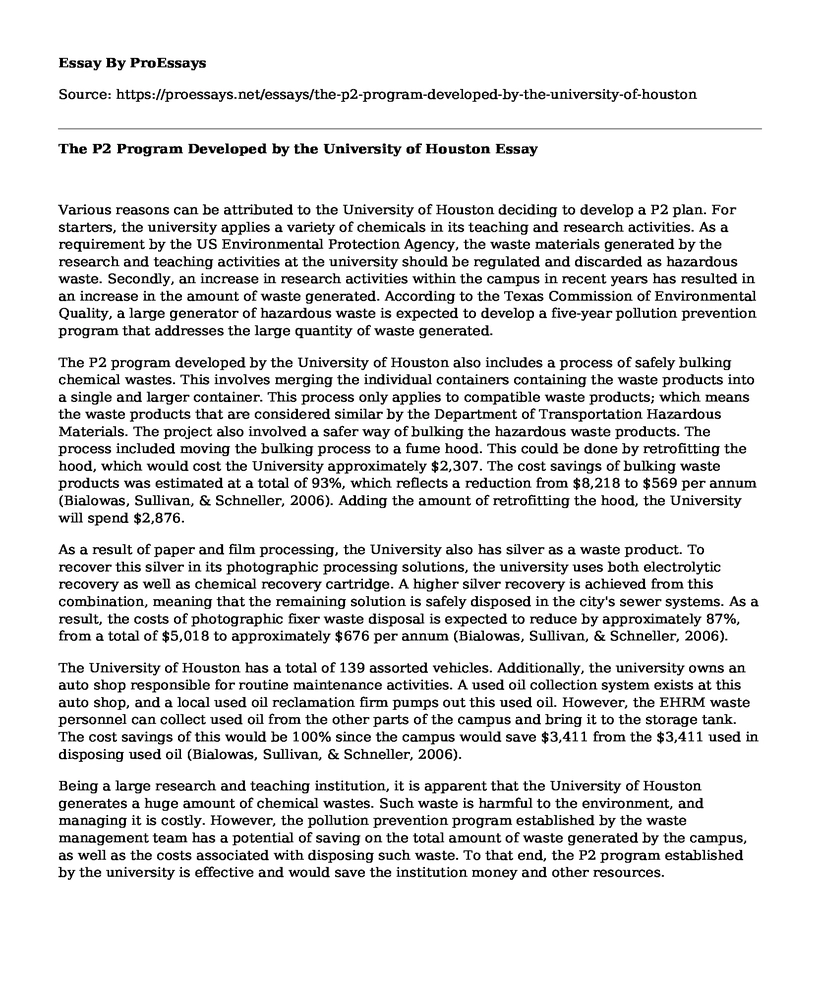Various reasons can be attributed to the University of Houston deciding to develop a P2 plan. For starters, the university applies a variety of chemicals in its teaching and research activities. As a requirement by the US Environmental Protection Agency, the waste materials generated by the research and teaching activities at the university should be regulated and discarded as hazardous waste. Secondly, an increase in research activities within the campus in recent years has resulted in an increase in the amount of waste generated. According to the Texas Commission of Environmental Quality, a large generator of hazardous waste is expected to develop a five-year pollution prevention program that addresses the large quantity of waste generated.
The P2 program developed by the University of Houston also includes a process of safely bulking chemical wastes. This involves merging the individual containers containing the waste products into a single and larger container. This process only applies to compatible waste products; which means the waste products that are considered similar by the Department of Transportation Hazardous Materials. The project also involved a safer way of bulking the hazardous waste products. The process included moving the bulking process to a fume hood. This could be done by retrofitting the hood, which would cost the University approximately $2,307. The cost savings of bulking waste products was estimated at a total of 93%, which reflects a reduction from $8,218 to $569 per annum (Bialowas, Sullivan, & Schneller, 2006). Adding the amount of retrofitting the hood, the University will spend $2,876.
As a result of paper and film processing, the University also has silver as a waste product. To recover this silver in its photographic processing solutions, the university uses both electrolytic recovery as well as chemical recovery cartridge. A higher silver recovery is achieved from this combination, meaning that the remaining solution is safely disposed in the city's sewer systems. As a result, the costs of photographic fixer waste disposal is expected to reduce by approximately 87%, from a total of $5,018 to approximately $676 per annum (Bialowas, Sullivan, & Schneller, 2006).
The University of Houston has a total of 139 assorted vehicles. Additionally, the university owns an auto shop responsible for routine maintenance activities. A used oil collection system exists at this auto shop, and a local used oil reclamation firm pumps out this used oil. However, the EHRM waste personnel can collect used oil from the other parts of the campus and bring it to the storage tank. The cost savings of this would be 100% since the campus would save $3,411 from the $3,411 used in disposing used oil (Bialowas, Sullivan, & Schneller, 2006).
Being a large research and teaching institution, it is apparent that the University of Houston generates a huge amount of chemical wastes. Such waste is harmful to the environment, and managing it is costly. However, the pollution prevention program established by the waste management team has a potential of saving on the total amount of waste generated by the campus, as well as the costs associated with disposing such waste. To that end, the P2 program established by the university is effective and would save the institution money and other resources.
References
Bialowas, Y. D., Sullivan, E. C., & Schneller, R. D. (2006). Designing a low-cost pollution prevention plan to pay off at the University of Houston. Journal of the Air & Waste Management Association, 56(9), 1320-1324.
Cite this page
The P2 Program Developed by the University of Houston. (2022, Jun 20). Retrieved from https://proessays.net/essays/the-p2-program-developed-by-the-university-of-houston
If you are the original author of this essay and no longer wish to have it published on the ProEssays website, please click below to request its removal:
- Should Children Carry Cell Phones To School? - Essay Sample
- Essay Example on Child Neglect: Denial of Basic Needs, Severe Consequences
- From Car Washing to Financial Policy: Essay Sample on My Journey
- Essay Example on Setting Up Daycare: Benefits for Kids of All Ages
- Advertising Rewires Kids' Minds: The Biological Effects on Child Development - Essay Sample
- Essay Example on Homeschooling: Flexibility & Isolation Challenges
- Essay Example on Humanitarian Governance: Global Emergence of an Order for People's Wellbeing







